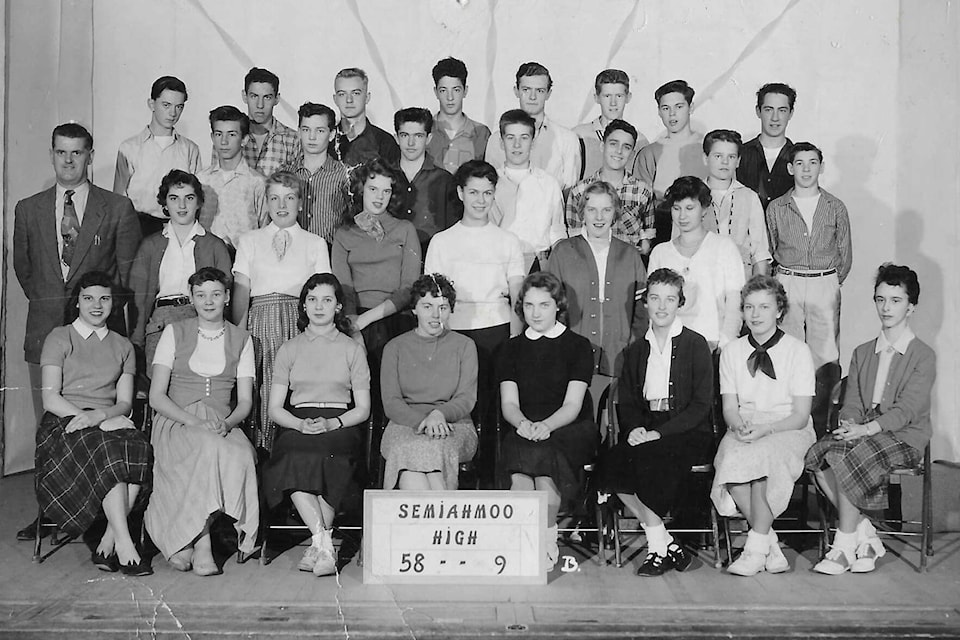Waves lap peacefully, seagulls squawk in the distance, a young girl picks up a pail and scoops a pile of sand with her pruny fingers, a teenager poses on the white rock, then jumps down with a yelp.
Laughter and cheers erupt.
A few older couples pause to look in their direction, but the kids are already on their way to their next adventure. There was a time when life was simple, and all a 16-year-old needed to think about was the quickest path to fun.
Longtime South Surrey resident Denny O’Donovan, who graduated from Semiahmoo Secondary in 1961, spoke recently, along with seniors Alex Matches and Lois Smith, about all the ways life in White Rock has changed for teenagers over the past several decades, whether for better or for worse.
Having fun is, of course, a timeless goal among teenagers.
Asked about their favourite ways to spend their free time in White Rock when they were young, Ms. Smith mentions “The Silver Moon,” an outdoor roller rink that opened in 1950, west of the White Rock pier. Going to the movies and playing sports were also popular sources of entertainment.
Camaraderie was at the heart of Mr. O’Donovan’s teenage experiences. He also talked about a sense of community.
“You knew everybody living in Ocean Park.”
The school bus, too, offered a source of connection and a sense of likeness. He noted how everyone got along (other than during a few occasional fights) — from that perspective, high school seemed to be a meaningful source of social connection.
Spending time at the beach, though, was by far the trio’s top choice – pier-jumping and swimming at White Rock beach were (and continue to be) a highlight of life in White Rock. Mr. O’Donovan described how his afternoons were always spent at the beach. The stresses of teenage life, Mr. O’Donovan said, were not comparable to today, with modern-day standards of success.
Though going to the beach is still fun, the time teens spend together outdoors today is greatly reduced. Countless distractions – whether it’s cellphones or video games – demand attention.
In our spare time, we often go our separate ways and reconnect through social media. Being in an isolated environment, focused on status and competition, may keep us from living our best life.
In the past, people may not have intended to live mindfully, but did so quite naturally. Drinking a morning cup of coffee, walking to the post office, writing letters, reading books, sitting in silence at the train station, all without the distraction of a cellphone, were all forms of mindfulness.
A lack of technology enabled everyday people to live in the moment. When your pocket is not constantly buzzing with notifications and you’re attuned to what is actually happening in front of you, you have greater awareness of the possibility of today, allowing you to be more creative and adventurous.
Finding interesting ways to fill time without the latest technology can be a challenge, but restricting how much time is spent online can create more oppportunities to hang out with friends and pursue hobbies.
While technology doesn’t stop today’s teens from being imaginative and social, it only takes one glance at a modern-day classroom to notice sleep-deprived, hazy eyes.
Today’s teens are taught that in order to be successful, they must be chasing some wild dream (like entering a prestigious university, getting a degree or a well-received job).
The increased stress and pressure that comes with these goals is unavoidable.
Mr. O’Donovan and Ms. Smith noted that, unlike today, as teenagers, they were not overly concerned with what was happening in the world. Rather, they were entertained by day-to-day happenings.
However, in a previous Peace Arch News article, Mr. Matches noted that in his own childhood, there was a widespread awareness of global events, especially the Second World War.
Global warfare and political events still caught public attention, but people were probably not as overly consumed in the media as we are now, they said.
Ms. Smith said that, as a teenager, life was simple because people were not as aware of things like climate change or politics.
She explained that she used to be very insulated, and did not have the kind of societal awareness lots of people have today.
Growing up in such a fast-paced world with so much technology, offers a different lens on the world, allowing teens to be more aware of world events and have a stance in politics and societal issues.
The internet has helped to expose diverse perspectives and embrace independent media more than ever before— whereas in the past, people more often lived in their own little bubble.
In 2023, the big challenge is to find balance in life – one that prioritizes both mindfulness and the pursuit of goals.
If we begin to hold value in everything we do, we can be present in our lives – instead of allowing life to pass by us.
Asked what he would tell his teenage self now, Mr. O’Donovan quotes his mother.
“Don’t waste your life away. Live for the moment.”
